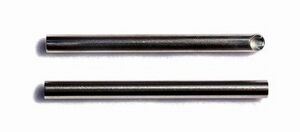Receiving tube: Difference between revisions
(Created page with "<html><div class="mw-content-ltr" dir="ltr" id="mw-content-text" lang="en"><div class="floatright"><a class="image" href="/index.php?title=File:Receivingtubes-1.jpg"><img alt="Receivingtubes-1.jpg" height="154" src="/images/7/74/Receivingtubes-1.jpg" width="350"/></a></div> <p>A <b>Receiving Tube</b> is a hollow tube used to receive a needle during a piercing. </p><p>In some piercings (<a class="mw-redirect" href="/index.php?title=Vertical_hood" title="Vertical hood">ver...") |
(Page conversion via llm-mediawiki-rev -jwm) |
||
| Line 1: | Line 1: | ||
[[File:Receivingtubes-1.jpg|thumb|right]] | |||
A '''Receiving Tube''' is a hollow tube used to receive a needle during a piercing. | |||
In some piercings ([[Vertical hood|vertical hood]], [[PA|PA]], and [[Nostril|nostril]] are good examples), the exit hole (that is, where the needle comes out during the piercing) is in a tight location. As such, the needle tip can easily do collateral damage to surrounding tissue. | |||
To combat this problem, a '''receiving tube''' is used. The end of the tube is butted up against the exit hole, and tissues are shielded from the needle by the walls of the tube. Receiving tubes are usually either flat ended, or cut at a diagonal to make receiving in places like the nostril easier. | |||
Receiving tubes are typically made from [[Stainless steel|stainless steel]], though more and more piercers are starting to prefer [[Single use|single use]] tubes made from [[PTFE|PTFE]] tubing. | |||
Latest revision as of 10:23, 17 September 2023
A Receiving Tube is a hollow tube used to receive a needle during a piercing.
In some piercings (vertical hood, PA, and nostril are good examples), the exit hole (that is, where the needle comes out during the piercing) is in a tight location. As such, the needle tip can easily do collateral damage to surrounding tissue.
To combat this problem, a receiving tube is used. The end of the tube is butted up against the exit hole, and tissues are shielded from the needle by the walls of the tube. Receiving tubes are usually either flat ended, or cut at a diagonal to make receiving in places like the nostril easier.
Receiving tubes are typically made from stainless steel, though more and more piercers are starting to prefer single use tubes made from PTFE tubing.
